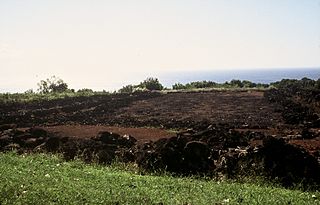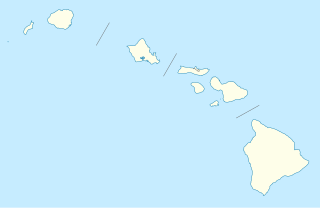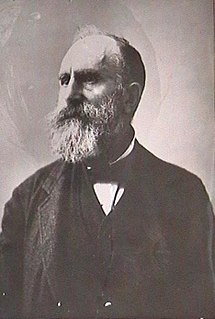
The island of Maui is the second-largest of the Hawaiian Islands at 727.2 square miles (1,883 km2) and is the 17th largest island in the United States. Maui is part of the State of Hawaii and is the largest of Maui County's four islands, which include Molokaʻi, Lānaʻi, and unpopulated Kahoʻolawe. In 2010, Maui had a population of 144,444, third-highest of the Hawaiian Islands, behind that of Oʻahu and Hawaiʻi Island. Kahului is the largest census-designated place (CDP) on the island with a population of 26,337 as of 2010 and is the commercial and financial hub of the island. Wailuku is the seat of Maui County and is the third-largest CDP as of 2010. Other significant places include Kīhei, Lahaina, Makawao, Pukalani, Pāʻia, Kula, Haʻikū, and Hāna.

Kalawao County is a county in the U.S. state of Hawaii. It is the smallest county in the United States both by population and land area.. The county encompasses the Kalaupapa or Makanalua Peninsula, on the north coast of the island of Molokaʻi. The small peninsula is isolated from the rest of Molokaʻi by sea cliffs over a quarter-mile high—the only land access is a mule trail.

The Hawaiʻian people practiced aquaculture through development of fish ponds, the most advanced fish husbandry among the original peoples of the Pacific. These fishponds were typically shallow areas of a reef flat surrounded by a low lava rock wall built out from the shore. Several species of edible fish thrive in such ponds, and Hawaiians developed methods to make them easy to catch.

Nuʻuanu Pali is a section of the windward cliff of the Koʻolau mountain located at the head of Nuʻuanu Valley on the island of Oʻahu. It has a panoramic view of the windward (northeast) coast of Oʻahu. The Pali Highway connecting Kailua/Kāneʻohe with downtown Honolulu runs through the Nuʻuanu Pali Tunnels bored into the cliffside.

Kalihi is a neighborhood of Honolulu on the island of Oʻahu in Hawaiʻi, United States. Split by the Likelike Highway, it is flanked by downtown Honolulu to the east and Mapunapuna, Moanalua and Salt Lake to the west.

Kalaupapa National Historical Park is a United States National Historical Park located in Kalaupapa, Hawaiʻi, on the island of Molokaʻi. Coterminous with the boundaries of Kalawao County and primarily on Kalaupapa peninsula, it was established by Congress in 1980 to expand upon the earlier National Historic Landmark site of the Kalaupapa Leper Settlement. It is administered by the National Park Service. Its goal is to preserve the cultural and physical settings of the two leper colonies on the island of Molokaʻi, which operated from 1866 to 1969 and had a total of 8500 residents over the decades.

Puʻu o Mahuka Heiau State Historic Site on the North Shore of Oʻahu is the largest heiau on the island, covering 2 acres (8,100 m2) on a hilltop overlooking Waimea Bay and Waimea Valley. Puʻu o Mahuka means 'Hill of Escape'. Hawaiian legends have it that from this point, Pele leaped from Oahu to the next island, Molokai. From its commanding heights, sentries could once monitor much of the northern shoreline of Oʻahu, and even spot signal fires from the Wailua Complex of Heiaus on Kauaʻi, with which it had ties. It was designated a National Historic Landmark in 1962, when it became the center of a 4-acre (16,000 m2) State park. It was added to the National Register of Historic Places in 1966.
Kahiwa Falls is a tiered waterfall in Hawaii located on the northern shore of the island of Molokai, between Wailau and Papalaua valleys. The waterfall is about 2165 feet tall, although often only 1749 feet of its drop are counted as the main fall.

Hokukano-Ualapue Complex is a National Historic Landmarked pre-contact archaeological site on several properties adjacent to Hawaii Route 450 in Ualapue, on Molokaʻi island.

Rudolph Wilhelm Meyer (1826–1897) was a German who managed an early agricultural business in the Kingdom of Hawaii.

Archeological Sites at Kawela are a number of archeological sites at or near the settlement of Kawela on the southern coast of Molokaʻi, the northernmost of the islands of Maui County, Hawaii. It was the site of two battles in Hawaiian history.

Waikolu Valley, also called Waikola, is on the North Shore of Molokai in Hawaii. Access to this uninhabited valley is currently restricted as it is a partly within the Kalaupapa National Historical Park.

Oloʻupena Falls, or Oloupena Falls, is a waterfall located in the north-eastern part of Hawaiian Island of Molokai, and is unofficially cited as the fourth highest waterfall in the world, and the highest in the United States.

The 2016 United States House of Representatives elections in Hawaii occurred on November 8, 2016. The electorate chose two candidates to act in the U.S. House, one from each of the state's two districts. Hawaii is one of 14 states that employ an open primary system, meaning voters do not have to state a party affiliation in the election. The primaries were held on August 13.

















